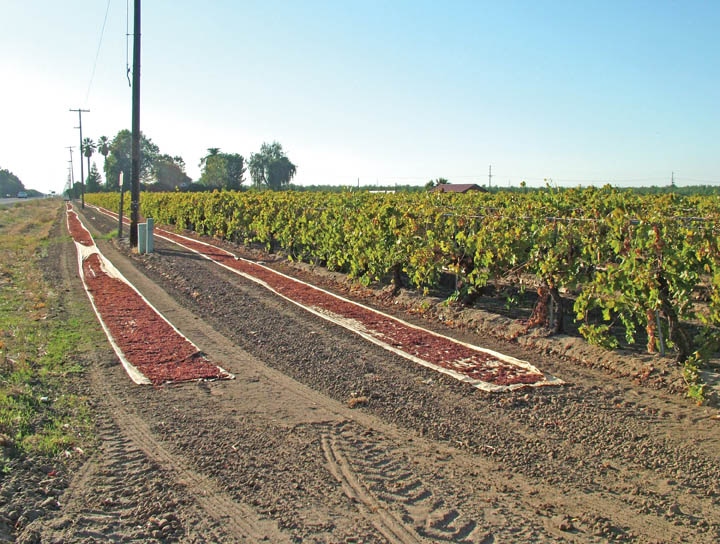October 18, 2011

As much as 50 percent of the California raisin crop was vulnerable to damage when heavy rains hit the valley earlier this month.
Much of that is still in the vineyards, slowly drying in mild fall weather or headed to dehydrators, creating an atmosphere of uncertainty for both growers and packers.
The anxiety is heightened not only by the fact this is the most valuable California raisin crop ever produced, but the eventual crop size will likely make it challenging for the industry to meet demand. The rain was only part of the reason the crop is coming up short. Competition from wineries for green Thompsons cut into the potential raisin supply.
The most valuable raisin crop in history is worth an estimated $500 million, the first time it has reached that mark.
Thousands of tons will require reconditioning to salvage. Barring any more damaging rain or fog, one packer estimates the eventual loss from the rain could be as much as 16,000 tons valued at $27 million. It will go higher — if there is more rain or cold, foggy weather.
Raisin packers, fearful green prices of $265 per ton or more would draw away growers from making much needed raisins, increased the established pre-harvest delivery price from $1,500 per ton to $1,700 per ton in the middle of harvest, trying to stem the flow of Thompson Seedless grapes to wineries. Before the harvest started, wineries set an opening price for Thompsons at $250 per ton.
It was an unprecedented bidding war, and growers were the benefactors.
It will be several weeks before the industry ascertains just how much of the crop was lost to the rains. Many growers rolled what crop they could with a very limited labor supply into paper trays before the rain started and unfurled them when the rain stopped. Raisin Bargaining Association Chief Executive Officer Glen Goto said many growers rolled raisins “heavy” before the rains hit to give partially dried bunches some protection.
“There were a lot of green berries in those rolls that had to be opened up after the rain. That put a lot of extra cost into an already expensive crop to farm,” said Goto.
Growers who harvested the grapes on continuous trays to dry could do little but watch the widespread rain totaling half inch to 1 inch from Merced to Delano soak the drying grapes.
With the rain, dehydrators stopped making Golden raisins and began drying Dried-on-the Vine (DOV) trellised raisins. DOV raisins are difficult to dry in the field and often are taken to dehydrators to finish drying down, even in a normal year. That was only exacerbated during this late, cooler, wet year.
Growers with rain-dampened raisins have little choice to leave them in the field to dry. “The drying time becomes substantially longer when temperatures are in the 70s and 80s versus the 90s to 100s we saw in September before the fall weather moved in,” said Goto.
Unless growers have time slotted at the dehydrator, there is nothing to do but wait. High moisture raisins cannot be rolled and stored in bins because they would rot in the wooden sweatboxes.
Signs of market challenges
All this points to a challenging marketing year for California raisins.
The raisin industry is selling raisins at a rate of 322,000 tons annually. This year’s crop has been estimated by the Raisin Administrative Committee to be 300,000 tons. Some consider that to be high.
Compounding the situation is an estimate by one major raisin packer that as many as 75,000 tons will be held back from being delivered to the packers, trying to force field prices even higher.
Larger growers have the money to hold their raisins during the first half of the crop year and can even hold them into the next crop year, betting the grape crop will be smaller in 2012, said one industry observer.
High prices and big demand for green and dried Thompsons would seemingly encourage new plantings of raisin grapes.
Not so fast, according to Gotto.
While the raisin industry looks like it may come up short on raisin supplies this year, there is far more uncertainty ahead in the wine grape/concentrate segment. What happens there has a direct impact on the raisin supply and price.
What wineries pay for 2012 Thompsons has a lot to do with marketing the 2011 crush: how much is left in the tanks by next fall and what are alternative sources for raisin-type grapes or other worldwide sources of concentrate like apples.
Goto said it is more costly to plant a new vineyard than a new orchard that is likely to offer far more income certainty.
When growers compare the cost of planting 700 vines per acre and all the trellising necessary compared to an almond orchard of 100 to 200 trees per acre of untrellised trees, it is a big gamble to plant a new Thompson or other raisin-type grape vineyard, according to Goto.
Goto readily admits there is optimism in the raisin industry and generally among Thompson growers, but that optimism translates into the hope prices are high enough to keep vineyards in the ground rather than encourage more planting. In the past decade, an estimated 80,000 to 100,000 acres of Thompsons have been pushed out. Raisins packers hope to stop the bleeding with the $1,700 price.
“With a $1,700 price for raisins and $265 for green Thompsons, you would hope people made enough money to hang around another year” and not plant attractive alternatives like almonds, said Goto.
About the Author(s)
You May Also Like






